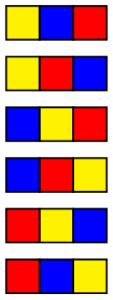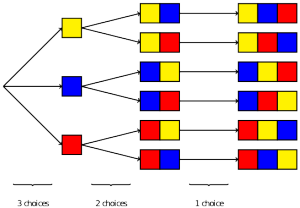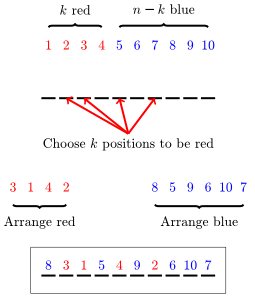Hello everyone!
This week, I'd like to talk about permutations. A permutation of a list is another list with the same elements in some order. For instance, imagine a deck of playing cards. Any way you shuffle the cards, you get the same cards, but you might get a different order. So the resulting ordering is a permutation of the original ordering.
It turns out that for permutations, the specific items in our list don't matter all that much. We can rename the items in the list however we like. For instance, we could take our deck of cards and give each a different color, or we could number them  . Then we can think of shuffling the cards as rearranging
. Then we can think of shuffling the cards as rearranging  colors or permuting the numbers
colors or permuting the numbers  through
through  .
.
The first thing we might want to know is how many permutations of  there are. For instance, when
there are. For instance, when  , we have
, we have  permutations, as shown below.
permutations, as shown below.
To answer more generally, let's look at each element of our list. There are  possible values that our list could start with. We can't reuse this first value, so there are
possible values that our list could start with. We can't reuse this first value, so there are  values that could come next. We can't reuse either of these values, so there are
values that could come next. We can't reuse either of these values, so there are  possibilities for the next value. And so on, until we're left with only one choice for the last value. That gives us
possibilities for the next value. And so on, until we're left with only one choice for the last value. That gives us  total permutations. That formula's a bit unwieldy, and it shows up a lot, so we usually simplify it to
total permutations. That formula's a bit unwieldy, and it shows up a lot, so we usually simplify it to  (pronounced "
(pronounced " factorial"). Thus, there are
factorial"). Thus, there are  permutations of
permutations of  elements.
elements. 
We're talking about combinatorics here, so let's count that a different way. Say we color the numbers  red and the numbers
red and the numbers  blue. How many ways can we permute them now?
blue. How many ways can we permute them now? First, let's choose which positions end up with a red number. We're trying to place
First, let's choose which positions end up with a red number. We're trying to place  numbers, and
numbers, and  of them are red, so we have
of them are red, so we have  ways to pick red numbers. (If you don't remember this symbol, I talked about it in a previous post.) We then have to pick an order for the red numbers, which as we saw earlier, can happen in
ways to pick red numbers. (If you don't remember this symbol, I talked about it in a previous post.) We then have to pick an order for the red numbers, which as we saw earlier, can happen in  ways. We also have to arrange the blue numbers, which can happen in
ways. We also have to arrange the blue numbers, which can happen in  ways. Putting it all together, we get
ways. Putting it all together, we get  permutations.But as we saw earlier, there are also
permutations.But as we saw earlier, there are also  permutations. So
permutations. So  . Rearranging, we get
. Rearranging, we get  . This gives us a nice formula for our binomial coefficients!
. This gives us a nice formula for our binomial coefficients!
There's plenty more to say about permutations. They lead naturally into topics like cycle decomposition, symmetric groups, and derangements. If you'd like to know more, I'm happy to talk about things in the comments.